ARC 1013 - Unit 3
0.0(0)
Card Sorting
1/81
Earn XP
Description and Tags
Study Analytics
Name | Mastery | Learn | Test | Matching | Spaced |
|---|
No study sessions yet.
82 Terms
1
New cards
renaissance
-mathematics, rational, proportions, universal order
-not aspire to heavens, grounded to earth, human reason
-symmetry
-circle and square pure form
-the activity, spirit or time of humanistic revival of classical art, literature and learning originating in Italy in the 14th century and extending into the 17th century making the transition from the medieval to the modern world
-not aspire to heavens, grounded to earth, human reason
-symmetry
-circle and square pure form
-the activity, spirit or time of humanistic revival of classical art, literature and learning originating in Italy in the 14th century and extending into the 17th century making the transition from the medieval to the modern world
2
New cards
gothic
-a-historical, asymmetrical
-architecture in service to God
-architecture in service to God
3
New cards
Renaissance 15th century
-began in Florence
-authentic re-use of classicism, based in understanding of perspective, change size and proportion of columns, pediments, etc
-represent human intellect as much as the power of God
-authentic re-use of classicism, based in understanding of perspective, change size and proportion of columns, pediments, etc
-represent human intellect as much as the power of God
4
New cards
humanism
Philosophical system based upon the capacity of humankind for rational, objective thought and action; stresses human reason and is centered in human nature, interests, and ideals, as distinct from religious philosophies based in a higher God
5
New cards
renaissance architecture
the various adaptations of Italian Renaissance architecture that occurred throughout Europe until the advent of Mannerism and the Baroque in the 16th and 17th centuries, characterized by the use of Italian Renaissance forms and motifs in more or less traditional buildings
6
New cards
Renaissance Man
-Brunelleschi
-cathedral in Florence; humanism
-reconcile the classical view of human potential with Christian belief in divine intervention
-wanted excellence in human achievement - all was possible
-cathedral in Florence; humanism
-reconcile the classical view of human potential with Christian belief in divine intervention
-wanted excellence in human achievement - all was possible
7
New cards
early renaissance
a style of Italian Renaissance art and architecture developed during the 15th Century, characterized by the development of linear perspective, chiaroscuro, and in buildings, by the free and inventive use of classical details
8
New cards
first Renaissance building
-Brunelleschi
-Foundling Hospital- Florence, Italy 1422
-symmetrical forms
-proportions relate one element to another
-application scientific perspective
-Foundling Hospital- Florence, Italy 1422
-symmetrical forms
-proportions relate one element to another
-application scientific perspective
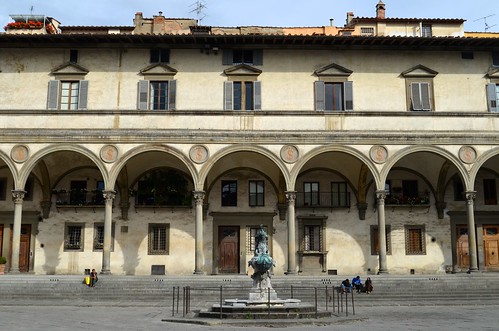
9
New cards
The Duomo
-Dome of the Cathedral of Florence 1418-1436
-largest dome built since the Romans
-technical achievement in its construction (no "centering" - built to be self-supporting as it was constructed)
-largest dome built since the Romans
-technical achievement in its construction (no "centering" - built to be self-supporting as it was constructed)
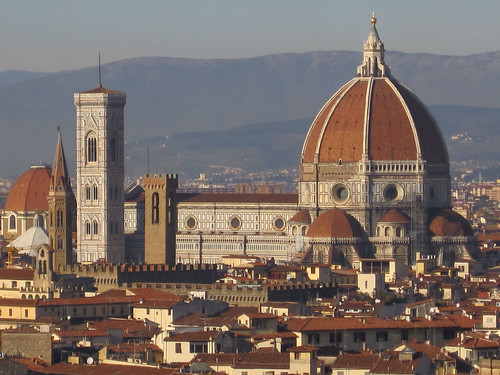
10
New cards
Brunelleschi
Church of San Lorenzo, Church of S. Spirito, Pazzi Chapel
11
New cards
Church of S. Spirito
-Fillipo Brunelleschi
-proportions and style fully realized
-volumes - CUBES
-CONSTRUCTED PERSPECTIVE
-proportions and style fully realized
-volumes - CUBES
-CONSTRUCTED PERSPECTIVE
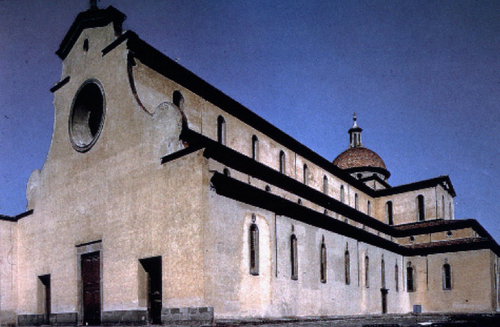
12
New cards
Vitruvius
-wrote "bible" for Renaissance architects
-Roman architect and theorist, active -46 to -25
-The TEN BOOKS ON ARCHITECTURE"
-two thoughts from him: "firmness, commodity, and delight", vitruvian figure
-believed platonic forms were "eternally and absolutely beautiful"
-circle and square become base DESIGN MODULES - based on whole number proportional relationships
-Roman architect and theorist, active -46 to -25
-The TEN BOOKS ON ARCHITECTURE"
-two thoughts from him: "firmness, commodity, and delight", vitruvian figure
-believed platonic forms were "eternally and absolutely beautiful"
-circle and square become base DESIGN MODULES - based on whole number proportional relationships
13
New cards
ten books on architecture
-Vitruvius
-the only complete book on architectural design and theory to survive from the ancient world
-had enormous influence on Renaissance architecture
-the only complete book on architectural design and theory to survive from the ancient world
-had enormous influence on Renaissance architecture
14
New cards
Leon Battista Alberti
-theorist, historian, scientist and architect
-another TEN books on architecture modeled on Vitruvius's books
-promote architecture as intellectual activity
-Church of Sant' Andrea
-another TEN books on architecture modeled on Vitruvius's books
-promote architecture as intellectual activity
-Church of Sant' Andrea
15
New cards
Villa Rotunda
-Vicenze, Italy
-Andrea Palladio
-supreme example of theoretically inspired design
-completely symmetrical
-elements all governed by proportional relationships
-turned house into a temple
-Andrea Palladio
-supreme example of theoretically inspired design
-completely symmetrical
-elements all governed by proportional relationships
-turned house into a temple
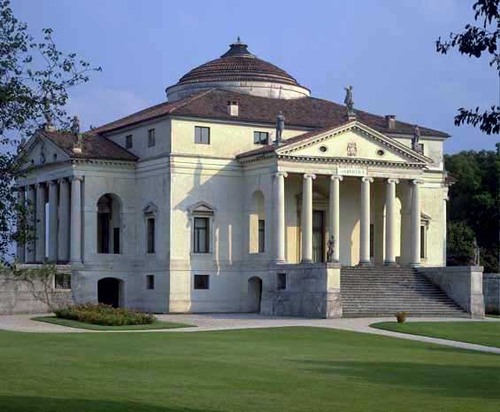
16
New cards
Andrea Palladio
-wrote treatise on architecture: THE FOUR BOOKS OF ARCHITECTURE
-constructed villas between Venice and Vincenza 1550
-Villa Rotunda
-constructed villas between Venice and Vincenza 1550
-Villa Rotunda
17
New cards
palazzo
city house
18
New cards
San Giorgio Maggiore
scaled to present a public face to the town of Venice
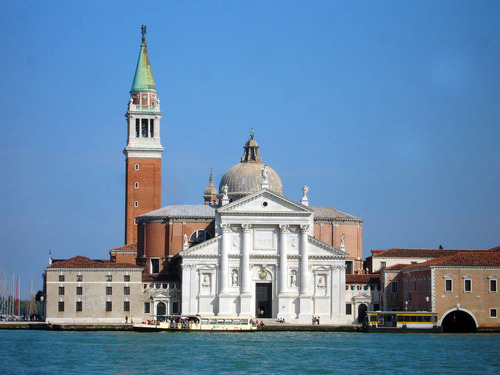
19
New cards
piazza
public square
20
New cards
high renaissance
a style of Italian Renaissance art and architecture developed during the late 15th century characterized by an emphasis on draftsmanship, the illusion of sculptural volume in painting, and in building, by the imitative use of orders and compositional arrangements in the classical style, with great attention to the formulation of compositional rules after the precepts of Vitruvius and the precedents of existing ruins
21
New cards
Donato Bramante
-1444-1514; The "Tempietto" of San Pietro; Tempietto, Rome; begun 1502
-was a close associate of Leonardo DaVinci; early work in Milan; moved to Rome after French sack of Milan in 1499
-circle and square represent the perfection of the divinity
-believe religious figure "Saint Peter" was killed (martyred) here
-meant to be an object, a picture, a marker
-was a close associate of Leonardo DaVinci; early work in Milan; moved to Rome after French sack of Milan in 1499
-circle and square represent the perfection of the divinity
-believe religious figure "Saint Peter" was killed (martyred) here
-meant to be an object, a picture, a marker
22
New cards
The "Tempietto" of San Pietro
Donato Bramante

23
New cards
Pope Julius II
-1503
-humanist ideals introduced into the Papal court
-Rome Queen City - consolidate temporal power
-return to glory from Roman antiquity
-humanist ideals introduced into the Papal court
-Rome Queen City - consolidate temporal power
-return to glory from Roman antiquity
24
New cards
Saint Peter's
-1505-1612
-Michelangelo changed it
-a magnificent new church over the crypt of St. peter
-come becomes an icon of "dome" often repeated
-tomb for Pope Julius II would not fit in old basilica (almost 1100 years old in 1505)
-Bramante's scheme was on a scale grander than any Roman structure
-building about the size of the Baths of Diocletian (dome comparable to the Pantheon)
-Michelangelo changed it
-a magnificent new church over the crypt of St. peter
-come becomes an icon of "dome" often repeated
-tomb for Pope Julius II would not fit in old basilica (almost 1100 years old in 1505)
-Bramante's scheme was on a scale grander than any Roman structure
-building about the size of the Baths of Diocletian (dome comparable to the Pantheon)
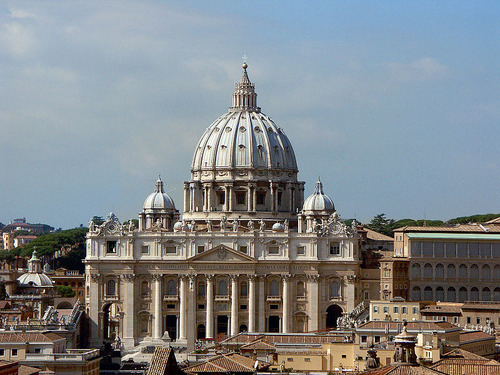
25
New cards
mannerism (high renaissance)
-inventive combinations of elements that purposefully play with classical rules
-proportions - exaggerated
-Michelangelo
-a transitional style in European architecture in the late 16th century, particularly in Italy, characterized by the unconventional use of the classical elements
-proportions - exaggerated
-Michelangelo
-a transitional style in European architecture in the late 16th century, particularly in Italy, characterized by the unconventional use of the classical elements
26
New cards
Laurentian Library
-1524
-Complete challenge to Renaissance rules of order, proportion, and use of historic elements
-Goal: to heighten physical experience of moving through space
-Michelangelo essentially manipulated classical architecture as elements in gigantic sculpture
-Complete challenge to Renaissance rules of order, proportion, and use of historic elements
-Goal: to heighten physical experience of moving through space
-Michelangelo essentially manipulated classical architecture as elements in gigantic sculpture
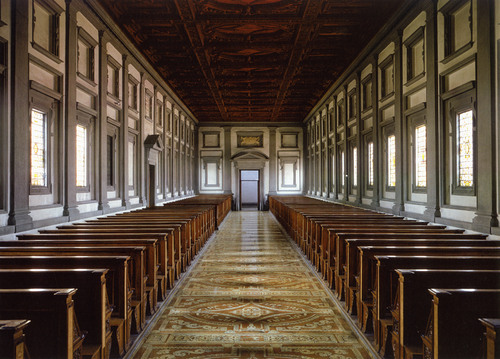
27
New cards
The "Campidoglio," Capitoline Hill
-1536
-Michelangelo Buonarroti
-Organization deviates from purity of Renaissance geometry
-Subtle tension of angled plan and oval plaza
-Ideas beginning to become "Mannerism"
-Michelangelo Buonarroti
-Organization deviates from purity of Renaissance geometry
-Subtle tension of angled plan and oval plaza
-Ideas beginning to become "Mannerism"
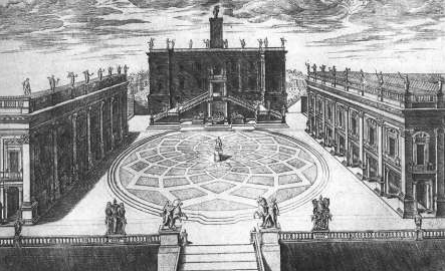
28
New cards
Inigo Jones
- 1572-1652
-Queen's house in Greenwich; begun 1616
-Balustrade - a railing supported by balusters
-Banqueting Hall in Whitehall, London, 1619-1622
-Queen's house in Greenwich; begun 1616
-Balustrade - a railing supported by balusters
-Banqueting Hall in Whitehall, London, 1619-1622
29
New cards
balustrade
a railing supported by balusters
30
New cards
Baroque
-ill formed pearl 17th century
-engage the emotions
-illusionary effects
-emphasize individual as part of society
-architecture for all social classes
-buildings design to fit context
-engage the emotions
-illusionary effects
-emphasize individual as part of society
-architecture for all social classes
-buildings design to fit context
31
New cards
Baroque Architecture
A style of architecture originating in Italy in the early 17th century and variously prevalent in Europe and the New World for a century and a half characterized by free and sculptural use of classical orders and ornament, dynamic opposition and interpenetration of spaces, and the dramatic combined effects of architecture, sculpture, painting, and the decorative arts
32
New cards
Bernini and Borromini the Baroque in Rome
-Reaffirmation of Catholic Church after the Protestant led Reformation
-Buildings to awe, convert
-Counter reformation: reintroduce spiritual values
-Something greater than the individual
-Buildings to awe, convert
-Counter reformation: reintroduce spiritual values
-Something greater than the individual
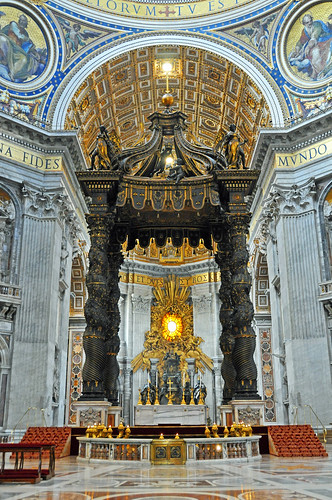
33
New cards
S. Carlo alle Quatttro Fontane
-Gianlorenzo Bernini and Francesco Borromini
-Rome
-begun 1634
-Bernini added collonade
-Rome
-begun 1634
-Bernini added collonade
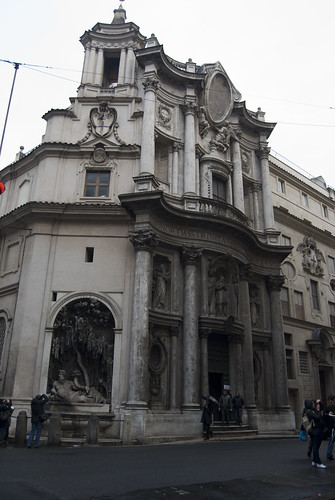
34
New cards
Piazza of St. Peters
-begun 1656
-Gianlorenzo Bernini
-Gianlorenzo Bernini
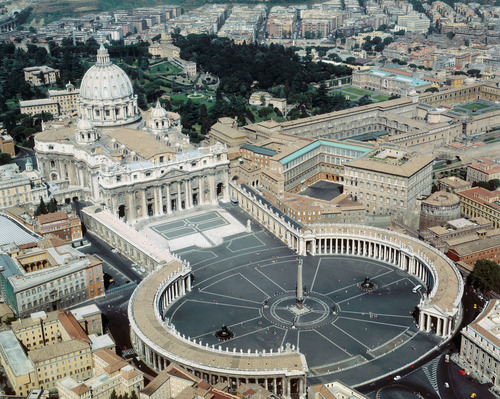
35
New cards
Piazza Navona
-Rome
-Bernini and Borromini, begun 1644
-Space dates the ancient Roman Circus
-Piazza: a public open place, square or marketplace, surrounded by buildings
-Bernini and Borromini, begun 1644
-Space dates the ancient Roman Circus
-Piazza: a public open place, square or marketplace, surrounded by buildings
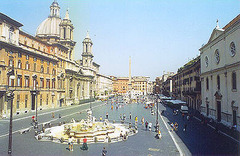
36
New cards
Bernini
-Baldacchino, St. Peter's Rome
-1624-1633
-aedicula
-1624-1633
-aedicula
37
New cards
aedicula
a small temple-like shrine which housed a statue or image of a deity, and was generally built as part of a larger structure
38
New cards
London - fire of 1666
-Act of rebuilding the city of London - example of an early building code
-Sir Christopher Wren redesigned St. Paul's Cathedral and over 50 other churches in London
-Sir Christopher Wren redesigned St. Paul's Cathedral and over 50 other churches in London
39
New cards
Sir Christopher Wren
-St. Paul's Cathedral - London 1675-1709
-St. Clemente Dane's - London
-St. Mary-Le-Bow
-St. Stephen Walbrook
-Royal Hospital in Greenwich 1696-1702
-St. Clemente Dane's - London
-St. Mary-Le-Bow
-St. Stephen Walbrook
-Royal Hospital in Greenwich 1696-1702
40
New cards
Nicholas Hawksmoore
-Christ Church - London 1714-1729
-St. Mary Woolnoth - London 1716-1724
-St. Mary Woolnoth - London 1716-1724
41
New cards
Versailles
-outside Paris
-Begun 1661
-Baroque
-Louis 14th; was hunting lodge
-The gardens included roughly 1400 fountains, using water pumped up from the Seine
-Parterre: gardens geometrically organized
-Extended baroque design of palace rooms into the landscape
-Vegetation - exotic to the region
-Allees: pathway lined with trees
-Begun 1661
-Baroque
-Louis 14th; was hunting lodge
-The gardens included roughly 1400 fountains, using water pumped up from the Seine
-Parterre: gardens geometrically organized
-Extended baroque design of palace rooms into the landscape
-Vegetation - exotic to the region
-Allees: pathway lined with trees

42
New cards
parterre
gardens geometrically organized
43
New cards
allees
pathway lined with trees
44
New cards
rococo
A style of decorative art that evolved from the Baroque, originating in France about 1720 and distinguished by fanciful, curved spatial forms and elaborate, profuse designs of shellwork and foliage intended for a delicate overall effect.
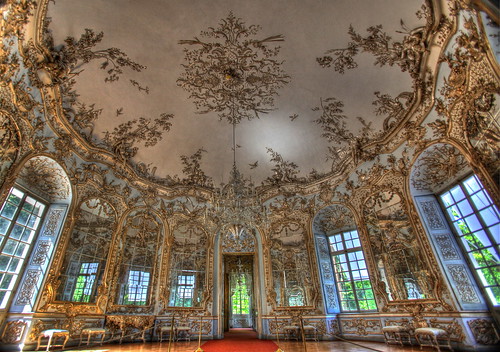
45
New cards
Dominikus Zimmerman
-Die Weis, church in rural Bavaria
-Zimmerman Brothers design structure disappears behind decoration
-Outside plain facades
-Intricate detail on interior
-Zimmerman Brothers design structure disappears behind decoration
-Outside plain facades
-Intricate detail on interior
46
New cards
revival of enlightenment
-Industrial revolution changed society dramatically
-New building types
-Architects respond by looking back: borrow styles from all eras and continents
-anti-Baroque go classical
-Motivated by archeological digs too
-The innovative architecture was designed by engineers
-New building types
-Architects respond by looking back: borrow styles from all eras and continents
-anti-Baroque go classical
-Motivated by archeological digs too
-The innovative architecture was designed by engineers
47
New cards
industrial revolution
-middle class emerges
-cast iron building material
-cast iron building material
48
New cards
neoclassical
-Georgian inspired from England; inspired from Palladio
-St. Martin-in-the-Field (1722-1726)
-James Gibbs design copied throughout the US
-St. Martin-in-the-Field (1722-1726)
-James Gibbs design copied throughout the US
49
New cards
federal style
-developed after American Revolution 1780-1820
-Copied from British architect Robert Adam (1728-1792)
-Copied from British architect Robert Adam (1728-1792)
50
New cards
Benjamin Latrobe
-Acknowledged as 1st professional architect
-Baltimore Cathedral
-Baltimore Cathedral
51
New cards
Pierre Charles L'Enfant
designed plan of Washington D.C.
52
New cards
Greek Revival Style
-Tennessee State Capitol Nashville, TN
-Minard Lefever
-Asher Benjamin
-Minard Lefever
-Asher Benjamin
53
New cards
Maison Carree in Nimes
Virginia State Capitol
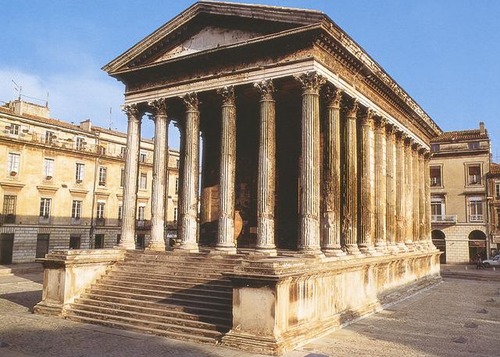
54
New cards
Violett-le-Duc
-1814-1879
-leading proponent of the Gothic Revival in France
-leading proponent of the Gothic Revival in France
55
New cards
gothic revival
Strawberry Hill
56
New cards
Beaux ARTS Neoclassical Eclecticism
-Charles Garnier
-Richardsonian Romanesque
-Henry Hobson Richardson
-Boston
-Trinity Church (1872-1877)
-Richardsonian Romanesque
-Henry Hobson Richardson
-Boston
-Trinity Church (1872-1877)
57
New cards
developments in the 19th century
-Industrialization
-Urbanization
-Beginnings of "global" marketplace of goods, ideas
-Advances in sciences and construction (Steel manufacturing, electricity and oil refining, "People moving" - mass transit, elevators)
-Architects slow to embrace industrial materials
-DEBATE: historical styles v. new forms
-Engineers change role of architect (engineers design advanced structures,
push limits of metal and glass, designed strong efficient structures)
-New building materials (cast iron, wrought iron, glass, steel) in industrial quantities
-Crowding cities - intra-structure problems
-NATIONALISM - want to establish identity through architecture using historical references
-Largest buildings since Roman times
-Designs for building that had never existed before
(railroad stations, covered public markets, asylums for mentally ill, housing for industrial working class, libraries, universities, etc.)
-Urbanization
-Beginnings of "global" marketplace of goods, ideas
-Advances in sciences and construction (Steel manufacturing, electricity and oil refining, "People moving" - mass transit, elevators)
-Architects slow to embrace industrial materials
-DEBATE: historical styles v. new forms
-Engineers change role of architect (engineers design advanced structures,
push limits of metal and glass, designed strong efficient structures)
-New building materials (cast iron, wrought iron, glass, steel) in industrial quantities
-Crowding cities - intra-structure problems
-NATIONALISM - want to establish identity through architecture using historical references
-Largest buildings since Roman times
-Designs for building that had never existed before
(railroad stations, covered public markets, asylums for mentally ill, housing for industrial working class, libraries, universities, etc.)
58
New cards
nationalism
want to establish identity through architecture using historical references
59
New cards
early modernism
-Crystal Palace
-Made of modular parts that could be disassembled and reassembled
-Standardized, made from industrial manufacturing processes
-Methodical organization of the building process used metal building technology
-Made of modular parts that could be disassembled and reassembled
-Standardized, made from industrial manufacturing processes
-Methodical organization of the building process used metal building technology
60
New cards
Crystal Palace
-Designed by Joseph Paxton (1851) for World's Fair, London
-No decoration, no historical references
-Architects and critics HATED IT!
-No decoration, no historical references
-Architects and critics HATED IT!
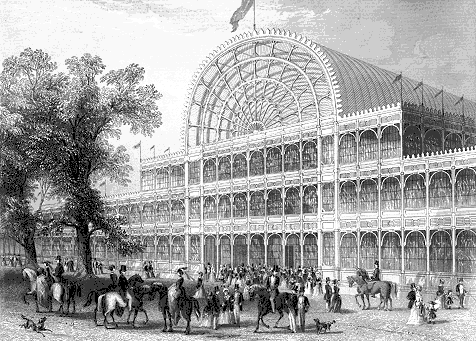
61
New cards
Henri Labrouste
-Bibliotheque Ste. Genevieve, Paris 1842-1850
-Symbolic train station
-Represent readers journey into knowledge
-Cast iron shaped into columns and arches support vaults and domes
-Symbolic train station
-Represent readers journey into knowledge
-Cast iron shaped into columns and arches support vaults and domes
62
New cards
Brooklyn Bridge
-1869-1883
-Suspension bridge
-Tension
-Suspension bridge
-Tension
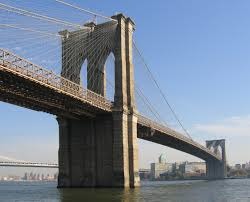
63
New cards
Gustav Eiffel
-Eiffel Tower
-Paris, 1885
-Iron construction
-Paris, 1885
-Iron construction
64
New cards
Chicago
-Forefront of American Architecture
-1871 fire
-CHICAGO SCHOOL of Architects
-1871 fire
-CHICAGO SCHOOL of Architects
65
New cards
Louis Sullivan
-Celebrate and express verticality in high rises
-Use light curtain wall material
-Express 3 zones on facade
-Father of the Chicago School of Architects
-Adler and Sullivan (Chicago Opera House)
-Use light curtain wall material
-Express 3 zones on facade
-Father of the Chicago School of Architects
-Adler and Sullivan (Chicago Opera House)
66
New cards
Burnham and Root
Rookery, Chicago
67
New cards
F. L. Olmstead
-Central Park
-Father of Landscape Architecture in America
-Biltmore - Vanderbilt Mansion - Asheville, NC
-Columbia Exposition of 1893, Chicago
-Father of Landscape Architecture in America
-Biltmore - Vanderbilt Mansion - Asheville, NC
-Columbia Exposition of 1893, Chicago
68
New cards
Frank Lloyd Wright
-American (Chicago) architect (1869-1959)
-Acknowledged as the most significant American architect of the 20th century
-Stylistic developments
1) Early work - "Arts and Crafts" - derived style
2) "Prairie" style - modern, horizontality, interwoven spaces
3) Mature style - more expressionistic
-Robie House 1908-09
-Unity Temple 1909
-Falling Water 1934-1937
-Guggenheim Museum 1943-1959
-Acknowledged as the most significant American architect of the 20th century
-Stylistic developments
1) Early work - "Arts and Crafts" - derived style
2) "Prairie" style - modern, horizontality, interwoven spaces
3) Mature style - more expressionistic
-Robie House 1908-09
-Unity Temple 1909
-Falling Water 1934-1937
-Guggenheim Museum 1943-1959
69
New cards
Peter Behrens
-Berlin
-AEG Turbine Factory
-1909 - Berlin
-AEG Turbine Factory
-1909 - Berlin
70
New cards
Fagus Factory
-Germany
-1911
-Walter Gropius
-international style
-1911
-Walter Gropius
-international style

71
New cards
international style
-Designing buildings for the world
-Theoretically: an abstract style that could fit anywhere
-Ludwig Mies van der Rohe (MIES as he is known)
(Barcelona Pavilion, Seagram's Building, God is in the Details)
-Theoretically: an abstract style that could fit anywhere
-Ludwig Mies van der Rohe (MIES as he is known)
(Barcelona Pavilion, Seagram's Building, God is in the Details)
72
New cards
Ludwig Mies van der Rohe
-Barcelona Pavilion
-Seagram's Building (God is in the details)
-Seagram's Building (God is in the details)
73
New cards
Bauhaus
-School in Germany - founded 1919 by Walter Gropius
-Huge influence on modern architecture
-Concept: art, design, and construction are united (like Gothic arch)
-Promoted "form follows function"
-Political purpose - housing for masses
-About the collective
-Huge influence on modern architecture
-Concept: art, design, and construction are united (like Gothic arch)
-Promoted "form follows function"
-Political purpose - housing for masses
-About the collective
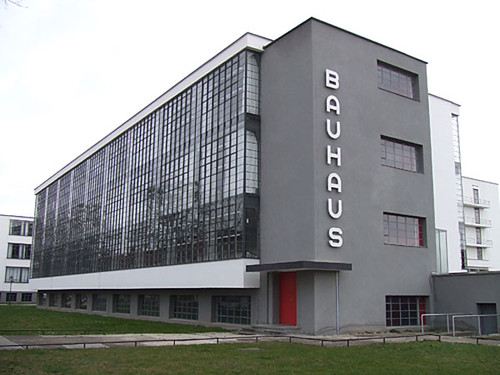
74
New cards
Le Corbusier
-Charles-Edouard Jeanneret-Gris
-French architect - 1887-1966
-One of the most significant architects of the modern movement, and the whole 20th century
-"Maison Dom-Ino"
-Cities and urban landscape designed the same way
-GRID form representing modernity, newness, and efficiency
-Le Corbusier Unite d'habitation, 1953-1955
-Villa Savoye, 1929-1931
-French architect - 1887-1966
-One of the most significant architects of the modern movement, and the whole 20th century
-"Maison Dom-Ino"
-Cities and urban landscape designed the same way
-GRID form representing modernity, newness, and efficiency
-Le Corbusier Unite d'habitation, 1953-1955
-Villa Savoye, 1929-1931
75
New cards
Maison Dom-Ino
-Le Corbusier
-Complete reduction of a house to elemental form
-Idea of the UNIVERSAL house
-Complete reduction of a house to elemental form
-Idea of the UNIVERSAL house
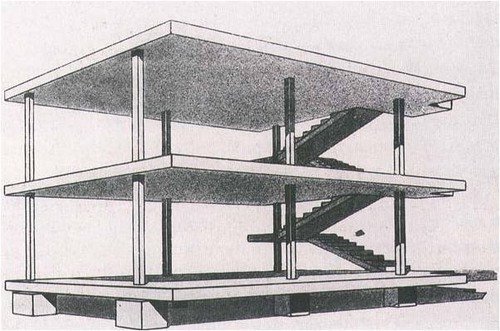
76
New cards
William Van Alen
Chrysler Building
77
New cards
Eero Saarinen
-TWA Terminal
-Dulles Airport
-St. Louis Gateway Arch
-Dulles Airport
-St. Louis Gateway Arch
78
New cards
Renzo Piano and Richard Rogers
Pompidou Center 1971-1972
79
New cards
Louis Kahn
Phillips Exeter Academy Library 1965-1972
80
New cards
postmodernism
-End belief in science to cure social ills
-FAILURE OF SCIENCE!
-Against "universalizing" processes - monarchy, aesthetics, modernism
-For "contextual" processes - capitalism, computer technologies, media
-Demolition of the Pruitt-Igoe Housing complex
"End of modernism in architecture"
-FAILURE OF SCIENCE!
-Against "universalizing" processes - monarchy, aesthetics, modernism
-For "contextual" processes - capitalism, computer technologies, media
-Demolition of the Pruitt-Igoe Housing complex
"End of modernism in architecture"
81
New cards
Robert Venturi and Denise Scott Brown
-LESS IS A BORE!
-Vanna Venturi House 1964
Chestnut Hill, PA
-Guild House 1960-1965
Philadelphia, PA
-Vanna Venturi House 1964
Chestnut Hill, PA
-Guild House 1960-1965
Philadelphia, PA
82
New cards
Michael Graves
-post-modern
-Swan and Dolphin Hotels, Disney World
-Swan and Dolphin Hotels, Disney World